DEGAS 2 Artwork
All of these images began as the result of research oriented visualization.
Some still very closely resemble the originals (see the various posters
listed elsewhere on this site). The rest
were tweaked and fiddled with to see just how pretty I could make them.
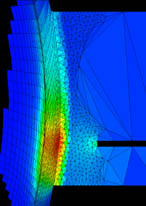
This shows the mesh used for the Alcator C-Mod gas puff imaging simulations.
The color contours are of the H-alpha emission.
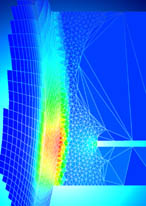
The same image doctored in Photoshop.

This is a 2-D image of a C-Mod GPI simulation in which a long-wavelength
pattern has been imposed on the background plasma. The gas puff is coming
from the left, and the core plasma is on the right. I.e., the image has
been flipped horizontally relative to the mesh plots shown above.

The same data plotted with a different color map.

This is a 2-D image of a C-Mod GPI simulation in which a short-wavelength
pattern has been imposed on the background plasma.

The same data plotted with a different color map.
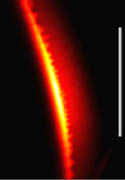
This is a 2-D image of one of the early simulations of NSTX GPI with an
H-mode plasma. The gas is coming from the manifold on the right.
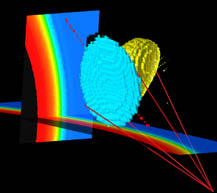
This is a visualization of one of the 3-D NSTX GPI simulations. The yellow
object is an isosurface of the neutral density; the gas is coming from
behind it. The blue object is an
isosurface of the emission rate. The rainbow colored planes are electron
density contours. The straight red lines are the corners of the GPI
camera view. The dotted red line represents a field line.
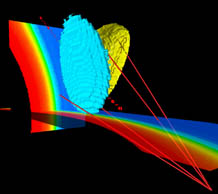
This is the same image, but with the "perspective" feature in AVS/Express
turned on. The outline of the gas manifold can be seen here inside the
yellow density isosurface.
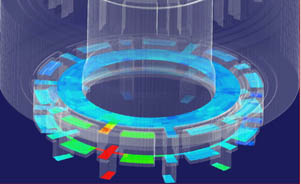
This is a visualization of the neutral pressure in the DEGAS 2 simulation of
the Alcator C-Mod gas conductance measurement experiments. The white,
ghostly isosurface is the outline of the vacuum vessel. Three
horizontal isoplanes are shown; the middle one is closest to the gas
source. This is the open divertor case.
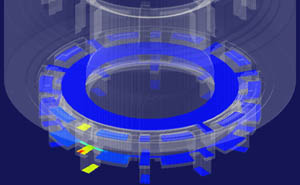
This corresponding closed divertor case.






